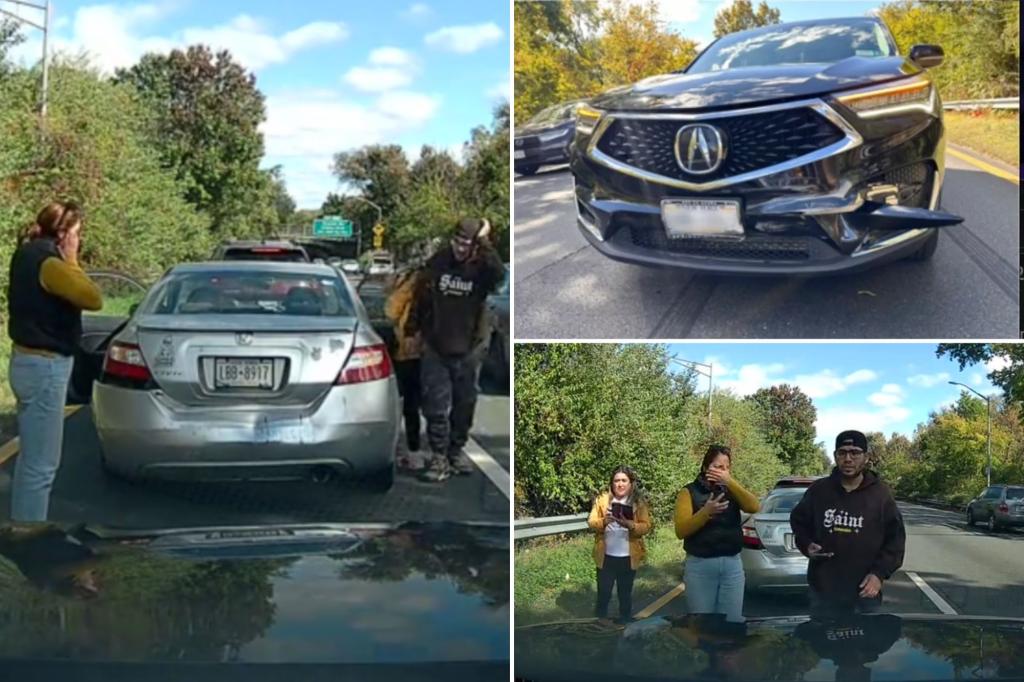The NYPD is investigating the disturbing staged accident on the Belt Parkway that went viral on TikTok — as experts said such insurance scams are on the rise in New York because fraudsters are “getting away with it.”
A police spokesperson said Tuesday that detectives have interviewed victim Ashpia Natasha about the caught-on-dash cam Oct. 16 crash, in which another driver reversed into her front bumper on the busy Queens highway just before several passengers spilled out and tried to claim they were hurt.
“The investigation remains ongoing by the NYPD Criminal Enterprise Investigation Unit’s Fraudulent Collision Investigation Squad,” a department spokesperson said in a brief statement.
Unfortunately, cases like Natasha’s are becoming more and more common as brazen crooks search for scams to run on unsuspecting victims — even old-school schemes like cutting someone off, slamming on the brakes and then squeezing them for insurance money afterward.
“It’s an ongoing trend, and the fraudsters are getting away with it,” Mark Friedlander, spokesperson for the Insurance Information Institute, a nonprofit trade organization, told The Post on Tuesday.
“They’re able to cash in on these schemes, and until they’re caught and put behind bars, the schemes are not going to slow down.”
Friedlander said staged accidents like the one on the Belt Parkway cost insurers about $20 billion every year — and raise the rates for everyone else.
They’re most common in heavily congested areas like California, which saw 5,366 staged crashes in 2023, and New York, which came in second last year with 1,729 such “accidents,” he said.
Those numbers are rising, especially in the New York metro area — the Empire State saw a 14% increase from 2022 to 2023, Friedlander said, while New Jersey saw a 58% increase, from 158 in 2022 to 250 in 2023.
More often than not, two cars will be involved — one in front of the victim and one in back — and they’ll sandwich their unsuspecting mark between them, Friedlander said.
Then, the conspiracy rings will rope in medical professionals who are willing to punch up the severity of the “injuries,” while lawyers on the take will sue the victimized driver on their behalf.
“It’s not just the people causing the fraudulent accidents,” Friedlander said. “It’s a much broader issue than just a few people in a vehicle causing this. It’s really amazing.”
And they’re leaving innocent victims in the lurch — like Natasha, whose incident was a “perfect example of an attempted insurance fraud scheme playing out in real time,” according to a rep for the National Insurance Crime Bureau.
The Belt Parkway seems to attract these crooks — another eerily similar incident happened on the same road recently, although it’s not clear when, according to a video posted on Reddit two days ago.
In that clip, a different silver Honda races up next to someone driving in the right lane and cuts them off — and predictably slams on the brakes.
The victim crashed into the scammers, who then pile out of the car, walking slowly and holding their necks as they amble around.
It’s not clear how the incident ended up, or if police believe the two crashes were committed by the same crew.
The NYPD did not respond to a request for comment Tuesday.
But there are some ways for motorists to protect themselves from becoming the next victim, including being a defensive driver (sometimes impossible in New York) and installing a dashcam, such as the one Natasha used to catch her would-be grifters.
She’d been driving on the three-lane parkway on Wednesday morning when the crew — driving a silver Honda Accord — suddenly switched lanes, cut her off and slammed on the brakes, according to a video she later posted to TikTok.
She hit her brakes too, narrowly avoiding a crash.
That’s when the other driver stopped in the shoulder-less lane, hit the hazards and backed into her.
Then four people got out of the Honda, acting like they were injured as they inspected the damage. A red Kia pulled up, picked up the suspected driver and took off.
Tom Burke, a retired NYPD detective who specializes in auto crime, said this means he was the ringleader.
“He’s the head guy — he’s the guy who went out and recruited these other morons to be victims in his scam,” said Burke, who is also an adjunct professor at John Jay College of Criminal Justice in Manhattan and a board member of the New York Anti-Car Theft & Fraud Association.
“That’s why he leaves the scene,” he continued. “He’s the main guy, he’s the one making the money. The other people are just idiots. You can’t make this stuff up.”
If there had been no dashcam recording, the rest might have played out exactly how Friedlander suspected.
“Those people are going to go through the motions,” Burke said of the passengers.
“They might get paid a few hundred dollars … and if they all complain that they have a physical injury, they’re going to go to some quack doctor who recommends physical therapy, etc. and they’ll hit the insurance company for that money.”
Burke added that this racket — which the National Insurance Crime Bureau calls a “swoop and squat” — tends to be more prevalent in old Eastern bloc countries.
But American crooks have picked it up.
“Stuff travels back and forth,” Burke said. “And people are always copying a scam that works.”
“And they’ll do it until they start getting locked up — and then they’ll do another one,” he continued.
“This type of stuff has been going on for ages.”
Read the full article here

